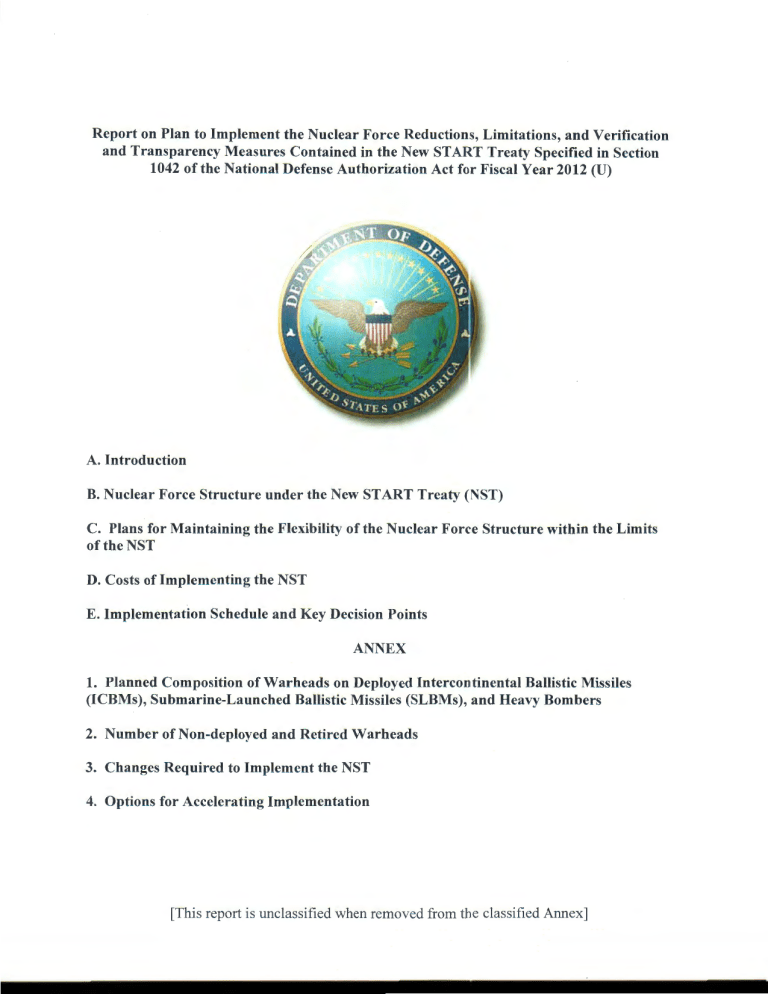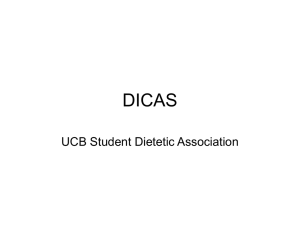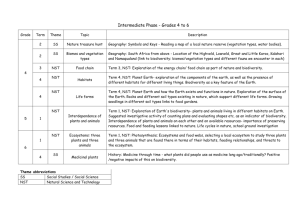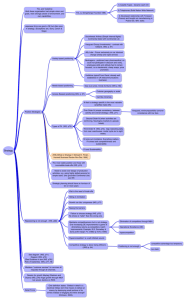Report on Plan to Implement the Nuclear Force Reductions, Limitations,... and Transparency Measures Contained in the New START Treaty Specified...

Report on Plan to Implement the Nuclear Force Reductions, Limitations, and Verification and Transparency Measures Contained in the New START Treaty Specified in Section
1042 of the National Defense Authorization Act for Fiscal Year 2012 (U)
A. Introduction
B. Nuclear Force Structure under the New START Treaty (NST)
C. Plans for Maintaining the Flexibility of the Nuclear Force Structure within the Limits of the NST
D. Costs of Implementing the NST
E. Implementation Schedule and Key Decision Points
ANNEX
1. Planned Composition of Warheads on Deployed Intercontinental Ballistic Missiles
(ICBMs), Submarine-Launched Ballistic Missiles (SLBMs), and Heavy Bombers
2. Number of Non-deployed and Retired Warheads
3. Changes Required to Implement the NST
4. Options for Accelerating Implementation
[This report is unclassified when removed from t h e classified Annex]
A. Introduction (U)
(U) This New START Treaty (NST) implementation plan is submitted in accordance with
Section 1042 of the National Defense Authorization Act (NDAA) for Fiscal Year (FY) 2012
(Public Law 112-81 ). The Secretary of Defense , in consultation with the Chairman of the Joint
Chiefs of Staff , the Secretaries of the Air Force and Navy , and the Commander, U.S
. Strategic
Command (USSTRA TCOM), is responsible for submitting this plan to Congress .
(U) This plan and the classified annex cover the details on how the Department of Defense
(DoD) intends to implement the nuclear force reductions , limitations , and verification and transparency measures contained in the NST. It includes:
• (U) A description ofthe nuclear force structure of the United States under the NST, including:
(U) the composition of intercontinental ballistic mis s iles (ICBMs ) , submarinelaunched ballistic missiles (SLBMs ) , and nuclear-capable heavy bombers; and
(U) the plans for maintaining the flexibility of the nuclear force structure within the limits of the NST.
• (U) The total costs associated with the reductions , limita t ions , and verification and transparency measures contained in the NST , and the funding profile by year.
• (U) An implementation schedule and associated key dec i sion points.
(U) The report includes a classified annex providing further det a ils on DoD implementation plans. The information provided in the annex covers:
• (U) The planned composition of the types and quantity of warheads for each delivery vehicle (i.e
.
, ICBM, SLBM, nuclear-capable heavy bomber)
• (U) The number of non-deployed and retired warheads .
• (U) A description of the changes necessary to implement the reductions , limitations , and verification and transparency measures contained in the NST , including how each
Military Department plans to implement such changes, a n d an identification of any programmatic , operational , or policy effects resulting from such changes.
• (U) A description of options for and feasibility of accelerating the implementation of the
NST , including any potential cost savings , benefits , or ri s ks resulting from such acceleration.
[This report is unclassified when removed from th ~ classified Annex]
B. Nuclear Force Structure under the New START Treaty (U)
(U) As set forth in the 2010 Nuclear Posture Review (NPR) Report, the United States will maintain a Triad of ICBMs, SLBMs, and nuclear-capable heavy bombers within the NST central limits. Specifically, the United States plans to retain a mix of si l o-based Minuteman III ICBMs in a single warhead configuration, Trident II SLBMs carried on OHIO-class strategic ballistic missile nuclear submarines (SSBNs), and B-2A and B-52H nuclear-capable heavy bombers.
(U) The NST establishes central limits on the number of nuclea r weapons and nuclear delivery platforms.
• (U) 700, for deployed ICBMs , deployed SLBMs, and deployed nuclear-capable heavy bombers
• (U) 800 , for deployed and non-deployed ICBM launchers , deployed and non-deployed
SLBM launchers, and deployed and non-deployed nuclear-capable heavy bombers
• (U) 1,550, for warheads on deployed ICBMs, warheads o n deployed SLBMs, and nuclear warheads counted for deployed nuclear-capable heavy b mbers
Composition of Strategic Delivery Vehicles (U)
(U) DoD intends to implement the force structure detailed in Table 1, below. This force structure fully supports U.S. strategy and conforms to NST central limits, while allowing flexibility to make later adjustments, as appropriate.
(U) Table 1: Final NST Force Structure
(U) 2014
Deployed and Non(U) 20 18 Deployed (U) 2018 Deployed
(U) Strategic Delivery Deployed ICBM and Non-Depl o yed and Non-Deployed
Vehicle (SDV) Type
Minuteman III ICBMs
Trident D5 SLBMs
B-2A/B-52H Bombers launchers, SLBM launchers, and
Heavy Bombers
454 1
336
96
2
ICBMs , SLBMs
Heavy Bombers
400
240
60
Launchers and
Heavy Bombers
454
280
66
TOTAL 886 700 800
454mcludes four operational test launchers at Vandenberg Air Force Base, and d oes not mclude 53 non-operatiOnal ICBM launGhers currently being eliminated.
2
96- includes 20 B-2A ( 19 deployed and one non-deployed test) aircraft and 76 B-5 2H (74 deployed and two non-deployed test) a ircr aft. Does not include 13 non-operational B-52H bomber s scheduled to be converted or eliminated .
[This report is unclassified when removed from the classified Annex]
C. Plans f or Ma int ai n ing the Flexibility of the Nuclear Force Struct u re within t h e Limits of the NST (U)
(U) The NST provides flexibility to each Party to determine its nuclear force structure .
Specifically, the NST provides that "each Party has the right to determine for itself the composition and structure of its strategic offensive arms within the Treaty's aggregate limits ," and does not mandate any schedules for the implementation of t he reductions beyond the requirement that the three NST central limits must be met within seven years after the NST's entry into-force.
(U) The United States will pursue a future nuclear force structu r e under the NST that will:
• (U) comply with the provisions of the NST;
• (U) maintain the viability of each Triad leg including the ability to hedge against the risk of a technical failure of any system or Triad elemen t ; and
• (U) satisfy the strategic targeting and planning requirem e nts set forth in classified DoD guidance for the employment of nuclear forces , including the hedge requirement; and
(U) To achieve the final NST force structure, the United States is making many reductions toward the end of the seven-year NST implementation period. T hroughout the duration of the
NST , the United States will retain the right and ability to adjust the Treaty compliant force mix as necessary.
(U) DoD will invest in its nuclear delivery systems to ensure th a t existing capabilities are adequately sustained with essential upgrades and modifications. DoD legacy systems are aging and the department is making the necessary sustainment and modernization investments to maintain a credible deterrent capability. Additionally , DoD will seek to modernize systems to ensure continuing deterrent capability in the face of evolving security challenges and technological developments.
[This report is unclassified when removed from the classified Annex]
D. Costs to Implement the New STA RT Treaty (U)
(U) Table 3 below illustrates the costs to implement the NST from Fiscal Year 2014 to 2018
(FY14-18).
(U) Table 2: Costs to Implement the NST (U)
Air Force (USAF) - ICBM ($M)
Eliminate Non-Operational ICBM
Launchers
De-MIRV ICBMs
Non-deploy 50 Operational ICBM
Launchers
(Storage/Transportation)
ICBM- Total
USAF - Bomber ($M)
Non-Operational Bomber
Elimination
Bomber Conversion
Bomber- Total
USAF Exhibitions and
Inspections
USAF- Total
FY2014 FY2015 FY2016 F Y2017 FY2018
14
0.7
4
.
.
7
3
19.7
0.4
0.5
0.9
5.7
26.3
16.0
0.7
6.2
22.9
0.4
0 .
2
0.6
6.0
29.5
0
0
4
.
.
2
7
.0
4.9
0 .
0
0 .
1
0.1
6.1
11.0
0.0
0.7
3.1
3.8
0 .
0
0 .
2
0.2
6.2
10.2
0
0
1.7
1.7
0 .
0
0.0
0.0
6.4
8.1
FY2014-
2018
TOTAL
30.9
2.8
30.4
85.2
19.3
53.0
I
0.8
1.0
1.8
I
USN - SSBN ($M)
Transportation and Storage
Materiel and Ballast Support
Research and Engineering
D5 Support Equipment
Navy Exhibitions and
Inspections
USN- Total
FY2014 FY2015 FY2016 FY2017
14 .
1
25 .
9
0.3
9 .
6
4.9
54.8
32.0
17.7
0.3
9 .
0
5.0
64.0
17.4
15.0
0 .
3
9.8
5 .1
47.6
14
4
0
.
.
.
0
3
3
7.8
5 .
2
31.6
FY2018
7.3
1 .
5
0 .
3
3 .
5
5.3
17.9
FY2014-
2018
TOTAL
84.8
64.4
1.5
39.7
25.5
215.9
DoD- Total
FY2014 FY2015 FY2016 FY2017
81.1 93.5 58.6 il
41.8
FY2018
26.0
FY2014-
2018
TOTAL
301.1
[This report is unclassified when removed from the classified Annex]
E. New START Treaty Implementation Schedule and Key Decision Points (U)
(U) The Joint Staff, USSTRATCOM, the Air Force , and the Navy have collaborated to create an integrated implementation schedule that will enable all require d reductions by February 5 , 2018, as required by the NST. The schedule is summarized below.
E l F
FY11 FY12 FY13 FY14 FY15 FY16
Eliminate Non-Operati nal PK/ MMIII/ Test
I ~ BM
Launch +
De-MIRY ICBMs
Eliminate Davis-Monthan B-
•
~ on-Deploy
I
Launchers
Convert/Eliminate B-
52Hs
Co + ertSSBN Laun c hers
'
FY17
1
I
I
I
I
I
I
I
I
I
I
Central Limits
FY18




